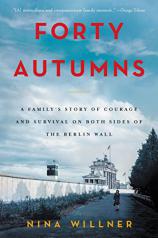Forty Autumns: A Family's Story of Courage and Survival on Both Sides of the Berlin Wall
Review
Forty Autumns: A Family's Story of Courage and Survival on Both Sides of the Berlin Wall
At the height of the Cold War and after years of training, Nina Willner became the first female Army Intelligence Officer to lead investigative operations in East Berlin. She risked her life daily in order to gather classified information for the US government about East Germany’s notoriously oppressed and closed society. Since leaving the post, she has spent nearly three decades working abroad in a variety of other government and non-profit positions, living in Moscow, Prague, Minsk, Ottawa and Istanbul.
FORTY AUTUMNS is Willner’s first book --- a memoir. But its focus isn’t on her years as a government operative, or her travels abroad as a wife and mother. In fact, she barely appears as a character at all. Instead, Willner shifts the attention off herself to dive deep into her family’s past and recount the hardship her ancestors endured for more than 40 years as a result of living on opposite sides of the Berlin Wall.
Beginning at the end of World War II, Willner describes in riveting detail what it was like in East Germany under communist rule. Her grandparents, whom she calls Oma and Opa, lived in a city called Schwaneberg and raised eight children. Oma, the backbone of the family, took care of the cooking and child rearing, while Opa served as a headmaster at the local school. Despite increasing restrictions placed on the family and most others in East Germany, Oma and Opa ran a tight but loving ship, ensuring their children remained close and looked after one another at all times.
"Willner’s knack for reporting world events is comprehensive and mostly spot on.... FORTY AUTUMNS is both an informative and timely read."
Willner centers the early and some of the most engaging sections of the book on Hanna, her mother. By the time Hanna was 18, she had grown increasingly disillusioned with what she saw as a tyrannical and repressive East German government. After two failed escape attempts and a stint at her grandparents’ farm in rural Seebenau --- a town on the edge of East and West Germany --- she risked everything to make one final try for freedom.
Luckily, Hanna made it across the border --- barely. But her success came at a cost. Most of the milestones that unfold in the second half of the book --- the arrival of a new baby sister, Heidi; Hanna’s marriage, move to America, and birth to two kids (including Nina); Heidi’s coming of age, marriage, and birth to a girl who grew up to be one of East Germany’s Olympic cyclists --- took place without barely any contact between Hanna and her family.
On the surface, FORTY AUTUMNS is the story of a family’s refusal to buckle under a ruthless East German dictatorship. Though an increasingly critical and outspoken Opa eventually became the target of communist officials, who banished him, Oma and Heidi, to an isolated and sparsely populated village as punishment and forced Opa to undergo “intensive reeducation training” at a psychiatric hospital, Willner hints that nothing could break the bonds her relatives formed with each other or weaken their spirit. As Oma aptly put it before she died, “We have survived East Germany with our human dignity intact. This life has not always been easy, but it has not made us bend. It has actually made us stronger. And we are strong because our souls are free.”
Though billed as a memoir and packed full of facts about the author’s heritage, FORTY AUTUMNS falls short when it comes to emotional resonance. Perhaps because of her background in Intelligence, Willner spends more time delineating historical events than making sure her characters --- long-lost East German aunts and uncles, her brother, even her parents --- come alive for the reader. In many sections, especially chapters recounting Hanna’s adjustment to new surroundings in America, we’re often left wondering who any of the people Willner mentions really were or what happened to them both during and after Soviet occupation. The exceptions are Willner’s grandparents, both vividly depicted, and Heidi, whose obsession with her eldest sister blossomed after she and Oma were given dispensation to visit the then-26-year-old Hanna in 1954 when Heidi was five years old.
In contrast, Willner’s knack for reporting world events is comprehensive and mostly spot on. Aided by a timeline that lists family and historical chronology side by side, she traces East Germany’s rise to ruin, from Berlin’s division into East and West territories, to the establishment of the VoPo police and Stasi, to Ulbricht’s ascension to power, the Warsaw Pact and the space race. Of particular interest, of course, are the chapters covering the construction of the Berlin Wall and the horrific accounts of the hundreds of people who died trying to make it to West Germany.
Minor shortcomings aside, FORTY AUTUMNS is both an informative and timely read. In this increasingly tumultuous modern era when borders, both theoretical and physical, have once again become the front lines of critical issues such as immigration reform, pervasive prejudice and terrorism, stories like Willner’s are especially important. They serve as powerful reminders not only of our capacity for evil, but also of our will to endure even under seemingly insurmountable circumstances.
Reviewed by Alexis Burling on October 7, 2016
Forty Autumns: A Family's Story of Courage and Survival on Both Sides of the Berlin Wall
- Publication Date: August 15, 2017
- Genres: Memoir, Nonfiction
- Paperback: 416 pages
- Publisher: William Morrow Paperbacks
- ISBN-10: 0062410326
- ISBN-13: 9780062410320





